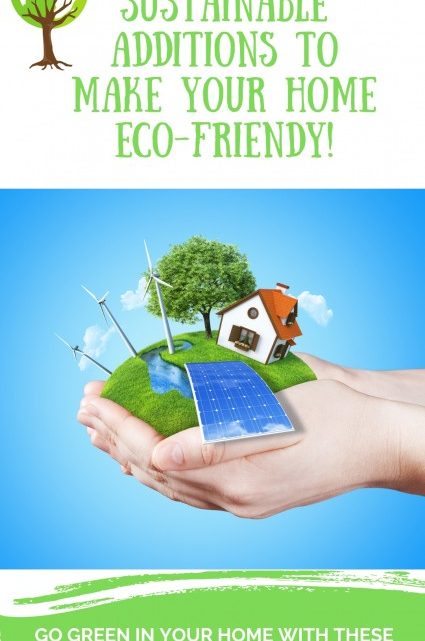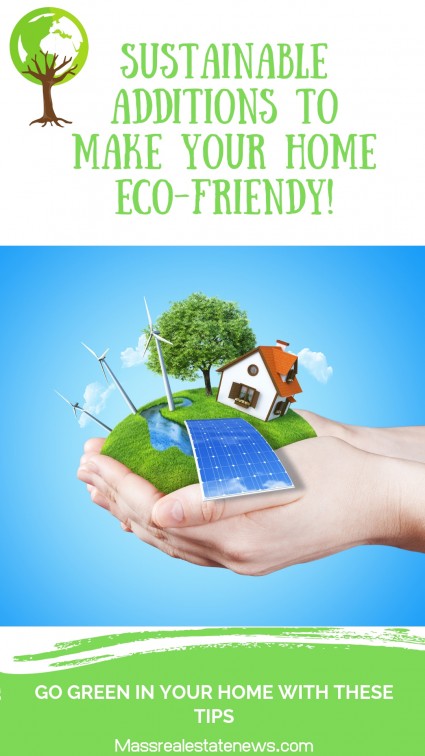Making Your Home More Eco-Friendly
The drive towards sustainable living is, much like our sick planet, heating up. But not everyone’s home has been built to an energy-efficient standard. I’ve put together seven sustainable add-ons for your home. Using these techniques, you can help cut energy use in your home and live more sustainably.
Use these and other green living ideas to help save the environment while also putting some money back into your pocket as well.
 Cut Out The Drafts
Cut Out The Drafts
A cold home requires more heat, making it much less energy efficient. The more ways you can find to cut out drafts and keep the house naturally warm, without the use of a heat source, the better. In fact, as much as 40% of heating can be lost through gaps and drafty walls!
Fitting thick window curtains and adding draft excluders to the bottom of doors is an easy first step in saving this lost heat. A more advanced and comprehensive procedure is to install caulking and weatherstripping in the gaps around windows and doors.
To trap the heat further, ensure there is adequate insulation in the walls, roof, and between the floor of the loft and ceiling underneath. For added ecological brownie points, choose insulation made from an eco-friendly material, such as straw or wool fiber.
Pro Tip: Get a blower door test done before and after your efforts to make your home more airtight. This test will reveal any gaps where the air is leaking through your walls and allow you to fill them.
Switch Up The Lighting
Electric light might be one of the wonders of the modern era, but it isn’t always very sustainable. There is a range of low energy light bulbs on the market which is easy to switch to. Simply unscrew your regular light bulb from the light fitting and screw an energy-efficient light-bulb in instead. LED (light emitting diode) bulbs are a popular choice.
The most prominent light source is the sun. Make use of windows in the property so that daylight time activities don’t need extra light. Some houses carve light wells in the roof; this involves making a small hole in the roof and putting a reflective tube down it too funnel more natural light into the area.
Sunlight can also be used to power solar panels to generate electricity.
Use Less Water
Using less water in your home is an easy route to sustainability. There is an ongoing debate of which is better, a shower or a bath; it’s easy to measure the amount of water that goes into a tub. However, a short shower may be more efficient. The old wartime trick of drawing a line around the bath to measure the water level is an excellent way to check how much water you’re using at bath time.
Buy a waterproof timer that you can fix to the shower to time how long a shower takes. You can also buy aerated shower heads which decrease the water by forcing air through the nozzles.
The toilet is the most natural place to save water. You can buy an inflatable balloon that you place in the cistern which takes up space so that the tank fills faster and uses less water. Environmental charities, local council departments, and the water board sometimes give away water-saving equipment for free.
Reclaim and Recycle
Good news for people who live in period homes, simply by living in an old building you are recycling your living quarters. If you can restore period features using building elements found in salvage yards, antique shops and sometimes even thrift stores, then this also counts as recycling.
If your house needs new flooring or similar, use recycled timber rather than causing more trees to be chopped down by using new wood.
Pick up furniture in thrift stores and then use basic DIY to restore the furniture to a livable state. To be even more Eco-friendly try reupholstering a chair or making a cushion using fabric from old clothes.
Install Energy Efficient Appliances
The most significant overhaul you can make to your property in terms of sustainable add-ons is changing over to energy efficient appliances. Everything that uses power in your home should be able to be swapped out for a more energy efficient version. When buying a new appliance, from the boiler to the oven and fridge, check the energy rating. An A grade appliance is considered the most efficient, but anything from a C upwards should be an improvement.
Replace Your Windows and Doors
As mentioned in add-on #1, windows and doors are major weak points in preventing home heat loss.
Most windows and doors are made from glass, wood, vinyl, and metal, which are all naturally poor insulators. For better insulation, fit triple-glazed windows with fiberglass frames, and doors with insulated cores.
Pro Tip. By replacing your windows and doors, it gives you the opportunity to install some of that caulking and weatherstripping we talked about in add-on #1.
Solar Panels
Adding solar panels is one of the best ways to be more Eco-friendly in your home. The installation of solar panels may not be cheap or easy, but they certainly have a significant impact on both your energy bills and your environmental footprint.
Installing solar panels can initially cost between $15,000 – $25,000, although government incentives help reduce this cost. Another option is to lease the panels and save yourself the upfront costs. Whichever option you choose, you should always complete an energy audit, and carry out other efficiency improvements first (see all the add-ons above). This way, your solar panel system will be the right size for your home’s needs.
Once operational, a solar system saves about $600 per year throughout its 25 to 30-year lifespan. You can expect this figure to grow as energy prices rise. You can even sell your unused electricity back to the grid or your neighbors – a win-win!
Final Thoughts
The seven add-ons listed above are just a few ways to reduce both your environmental footprint and your energy bills. More ideas can be found on Property Workshop.
You should now have more than enough ideas for easy sustainable projects that you can use to renovate your home. If you have found this guide useful, please share with your friends on social media.
Additional Helpful Real Estate Articles
- Things that should be repaired before selling a home – see some improvements that are worthwhile to make when you are going to be selling a home. These items have a high return on investment and will make your house sell quicker.
- What you should do when first moving to a new home – make sure you understand some of the smart things you should be doing when you go from one home to the next.
- Ways to increase your house value – learn some excellent ways to bump up the value of your property. If you are going to be selling your home in the near future, follow some of these sound suggestions.
The above resources are all terrific ways to learn more about the home buying and selling process. Use the articles to make the best real estate decisions.
About the author: The article on the top seven sustainable additions to your home was written by Vicky Prior. Vicky works for Property Workshop and is a blogger who spent her childhood suffering through many house renovations, but at least now is old enough to design rooms to her taste.













No Comment